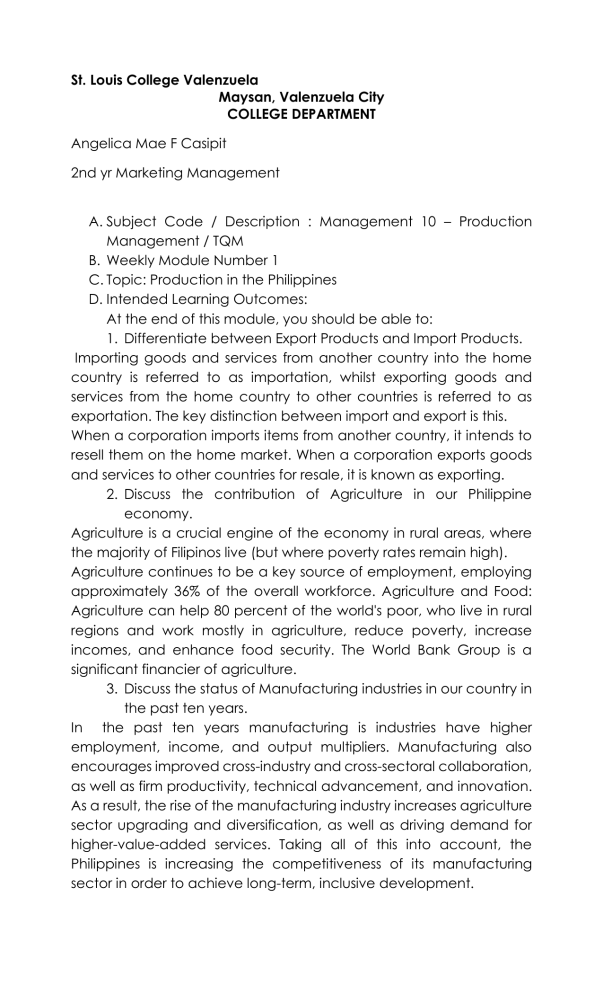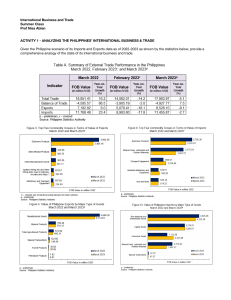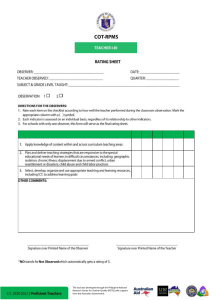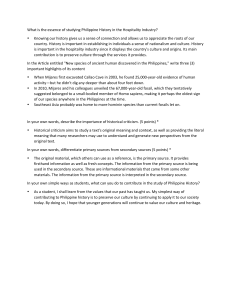
St. Louis College Valenzuela Maysan, Valenzuela City COLLEGE DEPARTMENT Angelica Mae F Casipit 2nd yr Marketing Management A. Subject Code / Description : Management 10 – Production Management / TQM B. Weekly Module Number 1 C. Topic: Production in the Philippines D. Intended Learning Outcomes: At the end of this module, you should be able to: 1. Differentiate between Export Products and Import Products. Importing goods and services from another country into the home country is referred to as importation, whilst exporting goods and services from the home country to other countries is referred to as exportation. The key distinction between import and export is this. When a corporation imports items from another country, it intends to resell them on the home market. When a corporation exports goods and services to other countries for resale, it is known as exporting. 2. Discuss the contribution of Agriculture in our Philippine economy. Agriculture is a crucial engine of the economy in rural areas, where the majority of Filipinos live (but where poverty rates remain high). Agriculture continues to be a key source of employment, employing approximately 36% of the overall workforce. Agriculture and Food: Agriculture can help 80 percent of the world's poor, who live in rural regions and work mostly in agriculture, reduce poverty, increase incomes, and enhance food security. The World Bank Group is a significant financier of agriculture. 3. Discuss the status of Manufacturing industries in our country in the past ten years. In the past ten years manufacturing is industries have higher employment, income, and output multipliers. Manufacturing also encourages improved cross-industry and cross-sectoral collaboration, as well as firm productivity, technical advancement, and innovation. As a result, the rise of the manufacturing industry increases agriculture sector upgrading and diversification, as well as driving demand for higher-value-added services. Taking all of this into account, the Philippines is increasing the competitiveness of its manufacturing sector in order to achieve long-term, inclusive development. F.Introduction and Engagement 1. Philippine industry moved forward, impelled by pressing economic responsibilities of gigantic proportions. Every possible incentive was extended by the government to help Philippines industry perform this herculean assignment. Grants in aid, statutory supports, and technical know-how were provided. Philippine industry responded to the challenge and started off by sponsoring the establishment of light and secondary industries. Among the earliest industrial complexes set up were textile mills, wood manufacturing plants, metal industries, food processing plants, and complementary service firms. Pulp and paper mills, cement plants, oil refineries, ceramics plants, milk processing plants, and automotive assembly, together with electronic and home appliance assembly plants followed. E. Presentation of the Topic/s 1. Please view or download the PowerPoint Presentation from our Production Management class in our Google Classroom (Chapter 1 – Production in the Philippines). 2. Please take down notes and answer the following questions: a. The Philippine Government adopted increased production in all sectors rather than price control as the basic policy to check spiraling prices. Weigh the advantages and disadvantages of such policy. b. Is the agriculture still the main propeller of Philippine economy? Explain. Agriculture is very important in the Philippine economy. It employs approximately 40% of Filipino employees and contributes an average of 20% of the country's GDP. c. Agriculture is the backbone of the Philippine economy. It employs around 3 million people, or almost 60% of all gainfully employed individuals .Agricultural operations account for 40 to 45 percent of overall national income and around 75 to 80 percent of exports. d. In the development of our country’s economy, should production in the agricultural sector be given higher priority than production in the manufacturing sector? Agriculture's role in economic growth Stimulates industrial growth: As the agricultural sector expanded, so did the industrial sector. When farmers save money, they can buy consumer goods and invest in businesses. As a result, the industrial sector expands indirectly. e. Cite the advantages and disadvantages of giving priority to the development of manufacturing over the development of agriculture For advantages manufacturing can employ a large number of workers with limited skill levels. Its processes are easily standardised and scaled, complementing urban economic clustering. and last for Disadvantages manufacturing technology has the following drawbacks: Limited Creative thinking -Due to the abundance of automation/machinery and a lack of employees within the manufacturing plant, manufacturing techniques completely limits creativity. f. “To solve the country’s economic problem,” says one, “we should raise more chickens than children”. Explain the statement. That is a legitimate concern for the nearly 1 billion people who live in extreme poverty today. Of course, there is no single correct answer, and joblessness manifests differently in different places. However, through my work with the foundation, I've met many people in developing countries who raise chickens, and I've learned a great deal about the intricacies of owning such creatures. F. Exercises 1. Research; Problems; and Projects a. Study our country’s current exports and imports and relate them to its productivity. Exports and imports are important for national economic development and growth because not all nations have the skills and resources needed to produce certain goods and services. Nonetheless, nations erect trade barriers such as tariffs and import quotas to protect domestic industries. A weakened domestic currency encourages exports while increasing the cost of imports; conversely, a strong domestic currency discourages exports while decreasing the cost of imports. b. Research on the extent of foreign investments in the Philippines and discuss the benefits provided by foreign participation in our industry. Amidst legal constraints, foreign investment has played an important role in the Philippine nation's growth. In 1948, foreign ownership accounted for approximately 50% of manufacturing, commerce, and mining assets, as well as 80% of power generation assets. G. Summative Assessment 1. Answer the Quiz 1 from our Production Management class in Google Classroom. 2. Online assessment during the video classes through recitation H. References 1. Production Management, Second Edition, Esdras T. Martinez




